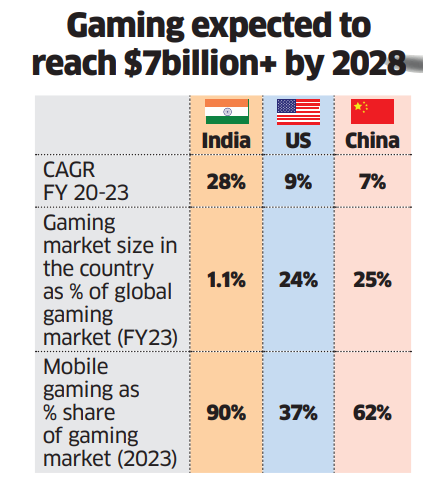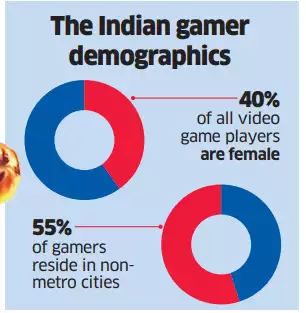India's Flourishing Gaming Industry
This editorial is based on “Getting to a new level in India’s online gaming sector” which was published in The Hindu on 07/05/2024. The article brings into picture the rise of India’s gaming sector and challenges associated with it.
For Prelims: Online gaming, Digital Economy, BharatNet, National Broadband Mission, 5G, IT (Intermediary Guidelines and Digital Media Ethics Code) Rules 2021, Animation, Visual Effects, Gaming, and Comics (AVGC) Promotion Task Force, Esports.
For Mains: Factors Leading to the Rise of the Gaming Industry in India, Major Challenges Related to India's Gaming Sector.
India's vibrant online gaming industry is rapidly gaining traction, fueled by a burgeoning digital economy and a tech-savvy population. With a burgeoning youth population, widespread accessibility to smartphones and high-speed internet, India's gaming sector is poised to leave an indelible mark on the global gaming landscape.
India is currently the largest gaming market in the world, boasting a user base of 568 million gamers and over 9.5 billion gaming app downloads in 2023. The sector in India has experienced an impressive growth trajectory, with a staggering 28% Compound Annual Growth Rate (CAGR) between FY20 and FY23. This remarkable growth is not only attracting significant foreign and domestic investments but also generating substantial direct and indirect employment opportunities.
What are the Factors Leading to the Rise of the Gaming Industry in India?
- Improved Internet Infrastructure and Connectivity: Development of broadband connectivity in Tier-II and Tier-III cities has expanded the reach of online gaming beyond just metro areas.
- Initiatives like BharatNet and the National Broadband Mission have aimed to provide high-speed internet access across rural and remote regions.
- The proliferation of 4G and the rollout of 5G networks have enhanced internet speeds and reduced latency, essential for seamless online gaming experiences.
- Affordable Access to Data and Smartphones: The decreasing costs of mobile data plans, driven by intense competition among telecom operators, have made data more accessible and affordable for online gaming.
- This democratization of technology has been a significant driving force behind the surge in online gaming adoption across socio-economic strata.
- India's current smartphone base is around 680 million, with over 80% of those being 4G smartphones (as per Counterpoint Research).
- Mobile phones contribute to 90% of the gaming market in India as compared to about 37% and 62% in the US and China, respectively.
- Cultural Shift and Changing Perceptions: The Covid-19 lockdown period accelerated the adoption of online gaming as a form of virtual entertainment and social connection.
- According to a June 2021 KPMG report, Indians' average time spent on online games increased from 2.1 hours per week (11% of total smartphone time) before the lockdown to 4.5 hours (15% of total smartphone time) within a month of the lockdown.
- This led to the gradual shift in perception, with online gaming transitioning from being viewed as a mere pastime to a viable career option.
- Government Support and Regulatory Clarity: Initiatives like the IT (Intermediary Guidelines and Digital Media Ethics Code) Rules 2021 have provided a regulatory framework for online gaming, addressing concerns about harmful content and addiction.
- The establishment of self-regulatory bodies and the Animation, Visual Effects, Gaming, and Comics (AVGC) Promotion Task Force have aimed to promote the industry's growth and development.

- The government's decision to allow 100% Foreign Direct Investment (FDI) in the gaming sector has opened up avenues for securing funding from international investors.
- Also, the government's recent recognition of gamers in the Content Creators Award 2024 is a significant step in enhancing the overall gaming sector.
- The establishment of self-regulatory bodies and the Animation, Visual Effects, Gaming, and Comics (AVGC) Promotion Task Force have aimed to promote the industry's growth and development.
- Rise of E-sports and Competitive Gaming: The inclusion of e-sports as a medal event at prestigious competitions like the Commonwealth Games 2022 and Asian Games 2023 has elevated its status and recognition as a legitimate sporting activity.
- The success of Indian teams and players on global esports platforms has further boosted the industry's profile and inspired aspiring gamers.
- India's online gaming segment currently accounts for a mere 1.1% of global online gaming revenue.
- Integration of Cutting-Edge Technologies: The incorporation of technologies like Augmented Reality (AR), Virtual Reality (VR), cloud gaming, and blockchain has enhanced the gaming experience and opened up new avenues for innovation.
- AR and VR offer immersive and interactive gameplay mechanics, while cloud gaming eliminates the need for high-end hardware, making gaming accessible across devices.
- Blockchain integration enables ownership of digital assets, tokenized economies, and interoperability across games and platforms, fostering increased engagement.
- Thriving Start-up Ecosystem and Investment Inflow: India's vibrant start-up ecosystem has given rise to numerous gaming companies and platforms, driving innovation and catering to the diverse gaming preferences of Indian consumers.
- India has produced 3 gaming unicorns: Game 24X7, Dream11 and Mobile Premier League.
What are the Major Challenges Related to India's Gaming Sector?
- Regulatory Ambiguity and Fragmented Policies: The lack of a cohesive and comprehensive regulatory framework for the gaming industry in India has created ambiguity and uncertainty for players in the sector.
- Different states have different laws and regulations governing online gaming, leading to a fragmented policy landscape.
- For example, while some states like Telangana and Andhra Pradesh have banned certain types of online games, others like Karnataka have adopted a more liberal approach.
- Taxation Concerns and Sustainability Challenges: The recent imposition of a 28% Goods and Services Tax (GST) on the total face value of bets has raised concerns about the long-term sustainability of the industry, particularly for smaller startups and players.
- Critics argue that this high tax rate could force many smaller gaming companies out of business, stifling innovation and hampering the industry's growth.
- Infrastructure and Connectivity Challenges: While significant improvements have been made, reliable and high-speed internet connectivity remains a challenge in many parts of the country, particularly in rural and remote areas.
- Only 31% of the rural population uses the Internet compared to 67% of their urban counterparts (India Inequality Report 2022).
- Content Localization and Cultural Relevance: Developing games and content that resonate with the diverse cultural and linguistic landscapes of India can be a challenge for game developers.
- For example, while some games like Ludo King have successfully adapted to local tastes, many international games struggle to find the same level of cultural resonance among Indian audiences.
- Responsible Gaming and Addiction Concerns: As the gaming industry grows, there are legitimate concerns about the potential risks of gaming addiction, particularly among younger populations.
- The prevalence of internet gaming disorder in the Indian population among school, undergraduate, and postgraduate students ranged from 1.3 to 19.9% for the adolescent group
- Recently, Installation of 'Beware of Smartphone Zombies,' signboards was seen in Bengaluru, a stark reminder of the growing epidemic of digital distraction.
What Measures can be Adopted to Enhance the Gaming Industry in India?
- Regulatory Clarity: Enhancing regulatory clarity is critical in the gaming sector, especially regarding the effective implementation of self-regulatory bodies mandated by the IT Rules of 2021.
- This is currently pending, undermining their intended impact, making it a pressing need of the hour.
- Dedicated Gaming Hubs and Incubators: Set up specialized gaming hubs and incubators in major cities to foster innovation, collaboration, and talent development.
- These hubs can provide state-of-the-art infrastructure, mentorship, and resources for game developers, startups, and aspiring professionals.
- Promote Game Development based on Indian Culture and Mythology: Encourage and incentivize game developers to create games based on India's rich cultural heritage, mythology, and folklore.
- This can help in building a unique identity for Indian games, catering to both domestic and international audiences.
- Example: Games like "Raji: An Ancient Epic" have successfully blended Indian cultural elements with engaging gameplay.
- Innovative Funding and Investment Models: Encourage alternative funding models like crowdfunding, venture capital investments, and public-private partnerships to support game development and startups.
- Example: Global gaming companies like Ubisoft have experimented with blockchain-based assets and in-game economies.
- Women- Trailblazers of India's Gaming Revolution: With women constituting a significant 40% of India's gaming populace, they are well-positioned to lead the country's gaming revolution.
- By empowering and supporting women in the gaming industry, India can unlock a wealth of talent, diverse perspectives, and innovative ideas that can drive the sector's growth and success.
- Promote Cross-Industry Collaborations: Foster collaborations between the gaming industry and other sectors like tourism, education, and hospitality to explore the potential of gamification and serious games.
- These cross-industry collaborations can lead to innovative applications of gaming technology in various domains.
|
Drishti Mains Question: The online gaming industry in India is witnessing rapid growth and has the potential to become a global hub. Analyze the factors driving this growth and the challenges faced by the industry. |
UPSC Civil Services Examination, Previous Year’s Question (PYQs)
Prelims
Q1. Which of the following is/are the aim/aims of “Digital India” Plan of the Government of India? (2018)
- Formation of India’s own Internet companies like China did.
- Establish a policy framework to encourage overseas multinational corporations that collect Big Data to build their large data centers within our national geographical boundaries.
- Connect many of our villages to the Internet and bring Wi-Fi to many of our schools, public places and major tourist centers.
Select the correct answer using the code given below:
(a) 1 and 2 only
(b) 3 only
(c) 2 and 3 only
(d) 1, 2 and 3
Ans: (b)


